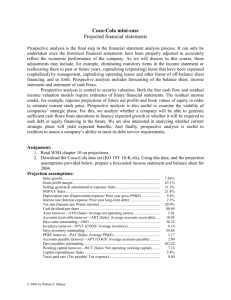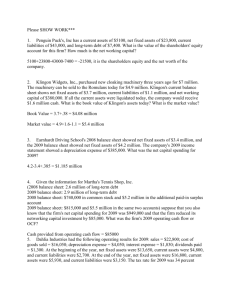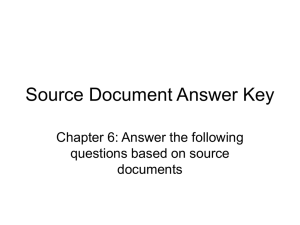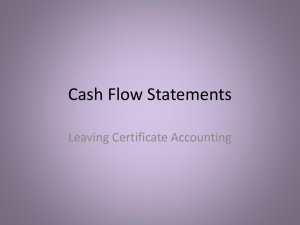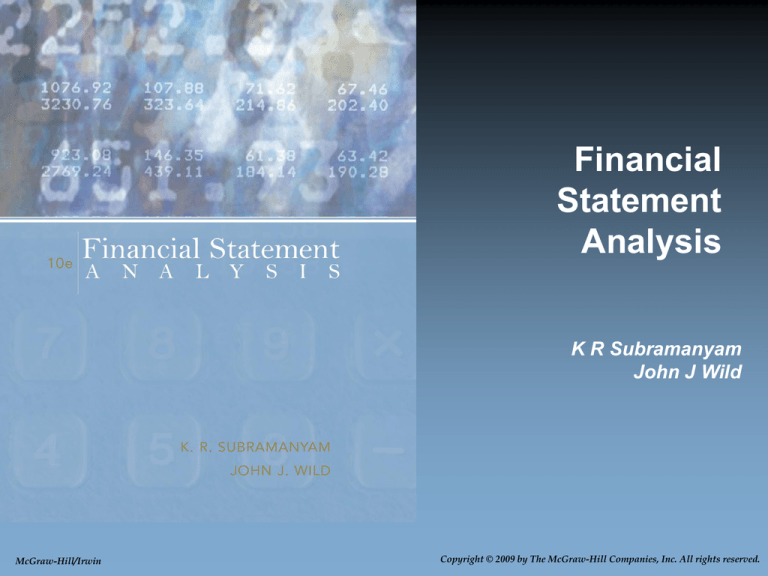
Financial
Statement
Analysis
K R Subramanyam
John J Wild
McGraw-Hill/Irwin
Copyright © 2009 by The McGraw-Hill Companies, Inc. All rights reserved.
9-2
Prospective Analysis
9
CHAPTER
9-3
Prospective Analysis
Importance
Security Valuation - free cash flow and residual
income models require estimates of future financial
statements.
Management Assessment - forecasts of financial
performance examine the viability of companies’
strategic plans.
Assessment of Solvency - useful to creditors to
assess a company’s ability to meet debt service
requirements, both short-term and long-term.
9-4
The Projection Process
Projected Income Statement
Sales forecasts are a function of:
1) Historical trends
2) Expected level of macroeconomic activity
3) The competitive landscape
4) New versus old store mix (strategic
initiatives)
9-5
The Projection Process
Target Corporation Income Statements
(in millions)
Sales..........................................................................................
Cost of goods sold .....................................................................
Gross profit................................................................................
Selling, general and administrative expense .............................
Depreciation and amortization expense .....................................
Interest expense.........................................................................
Income before tax ......................................................................
Income tax expense....................................................................
Income (loss) from extraordinary items
and discontinued operations.................................................
Net income.................................................................................
Outstanding shares ...................................................................
Selected Ratios (in percent)
Sales growth............................................................................
Gross profit margin..................................................................
Selling, general and administrative expense/Sales .................
Depreciation expense/Gross prior-year PP&E ...........................
Interest expense/Prior-year long-term debt ..............................
Income tax expense/Pretax income...........................................
2005
$46,839
31,445
15,394
10,534
1,259
570
3,031
1,146
2004
$42,025
28,389
13,636
9,379
1,098
556
2,603
984
2003
$37,410
25,498
11,912
8,134
967
584
2,227
851
1,313
$ 3,198
891
190
$ 1,809
912
247
$ 1,623
910
11.455%
32.866
22.49
6.333
5.173
37.809
12.336%
32.447
22.318
5.245
4.982
37.803
9-6
The Projection Process
Projected Income Statement
Steps:
1.
2.
3.
4.
5.
6.
Project sales
Project cost of goods sold and gross profit margins using
historical averages as a percent of sales
Project SG&A expenses using historical averages as a
percent of sales
Project depreciation expense as an historical average
percentage of beginning-of-year depreciable assets
Project interest expense as a percent of beginning-ofyear interest-bearing debt using existing rates if fixed
and projected rates if variable
Project tax expense as an average of historical tax
expense to pre-tax income
9-7
The Projection Process
Target Corporation Projected Income Statement
1.
2.
3.
4.
5.
Sales: $52,204 = $46,839 x 1.11455
Gross profit: $17,157 = $52,204 x 32.866%
Cost of goods sold: $35,047 = $52,204 - $17,157
Selling, general, and administrative: $11,741 = $52,204 x 22.49%
Depreciation and amortization: $1,410 =
$22,272 (beginning-period PP&E gross) x 6.333%
6. Interest: $493 = $9,538 (beginning-period interest-bearing debt) x 5.173%
7. Income before tax: $3,513 = $17,157 - $11,741 - $1,410 - $493
8. Tax expense: $1,328 = $3,513 x 37.809%
9. Extraordinary and discontinued items: none
10. Net income: $2,185 = $3,513 - $1,328
9-8
The Projection Process
Target Corporation Projected Income Statement
(in millions)
Forecasting Step
Income statement
Total revenues.........................................................................................
1
Cost of goods sold ..................................................................................
3
Gross profit.............................................................................................
2
Selling, general, and administrative expense ............................................
4
Depreciation and amortization expense ..................................................
5
Interest expense......................................................................................
6
Income before tax ...................................................................................
7
Income tax expense.................................................................................
8
Income (loss) from extraordinary items and discontinued operations ......
9
Net income..............................................................................................
10
Outstanding shares .........................................................................
Forecasting Assumptions (in percent)
Sales growth...........................................................................................
Gross profit margin.................................................................................
Selling, general, and administrative expense/Sales ...............................
Depreciation expense/Gross prior-year PP&E ..........................................
Interest expense/Prior-year long-term debt.............................................
Income tax expense/Pretax income .........................................................
2006 Estimate
$52,204
35,047
17,157
11,741
1,410
493
3,513
1,328
0
$ 2,185
891
1
1
1
1
1
1
11.455%
32.866
22.49
6.333
5.173
37.809
9-9
The Projection Process
Projected Balance Sheet
Steps:
1.
2.
3.
4.
5.
Project current assets other than cash, using projected sales
or cost of goods sold and appropriate turnover ratios as
described below.
Project PP&E increases with capital expenditures estimate
derived from historical trends or information obtained in the
MD&A section of the annual report.
Project current liabilities other than debt, using projected sales
or cost of goods sold and appropriate turnover ratios as
described below
Obtain current maturities of long-term debt from the long-term
debt footnote.
Assume other short-term indebtedness is unchanged from
prior year balance unless they have exhibited noticeable
trends.
(continued)
9-10
The Projection Process
Projected Balance Sheet
Steps:
6.
Assume initial long-term debt balance is equal to the prior
period long-term debt less current maturities from Step 4.
7. Assume other long-term obligations are equal to the prior
year’s balance unless they have exhibited noticeable trends.
8. Assume initial estimate of common stock is equal to the prior
year’s balance
9. Assume retained earnings are equal to the prior year’s
balance plus (minus) net profit (loss) and less expected
dividends.
10. Assume other equity accounts are equal to the prior year’s
balance unless they have exhibited noticeable trends.
9-11
The Projection Process
Target Corporation Balance Sheet
(in millions)
2005
Cash ..................................................................................
$ 2,245
Receivables .......................................................................
5,069
Inventories .........................................................................
5,384
Other current assets ..........................................................
1,224
Total current assets.......................................................
13,922
Property, plant, and equipment (PP&E)..............................
22,272
Accumulated depreciation .................................................
5,412
Net property, plant, and equipment ...................................
16,860
Other assets ......................................................................
1,511
Total assets .......................................................................
$32,293
Accounts payable...............................................................
$ 5,779
Current portion of long-term debt......................................504
Accrued expenses ..............................................................
1,633
Income taxes & other .........................................................
304
Total current liabilities .................................................. 8,220
Deferred income taxes and other liabilities........................
2,010
Long-term debt..................................................................
9,034
Total liabilities ..............................................................19,264
Common stock ...................................................................74
Additional paid-in capital..................................................
1,810
Retained earnings .............................................................
11,145
Shareholders’ equity......................................................
13,029
Total liabilities and net worth ............................................
$32,293
2004
$ 708
4,621
4,531
3,092
12,952
19,880
4,727
15,153
3,311
$31,416
$ 4,956
863
1,288
1,207
8,314
1,815
10,155
20,284
76
1,530
9,526
11,132
$31,416
2003
$ 758
5,565
4,760
852
11,935
20,936
5,629
15,307
1,361
$28,603
$ 4,684
975
1,545
319
7,523
1,451
10,186
19,160
76
1,256
8,111
9,443
$28,603
Selected Ratios
Accounts receivable turnover rate....................................
9.240
Inventory turnover rate.....................................................
5.840
Accounts payable turnover rate .......................................
5.441
Accrued expenses turnover rate .......................................
28.683
Taxes payable/Tax expense...............................................
26.527%
Dividends per share .........................................................
$ 0.310
Capital expenditures (CAPEX)—in millions ......................
3,012
CAPEX/Sales ....................................................................
6.431%
9.094
6.266
5.728
32.628
122.663%
$ 0.260
2,671
6.356%
6.722
5.357
5.444
24.214
37.485%
$ 0.240
3,189
8.524%
9-12
The Projection Process
Steps in Projection (Target)
1
2
3
4
5
6
7
8
9
10
11
12
13
14
15
16
17
Receivables: $5,650 = $52,204 (Sales)/9.24 (Receivable turnover).
Inventories: $6,001 = $35,047 (Cost of goods sold)/5.84 (Inventory turnover).
Other current assets: no change.
PP&E: $25,629 = $22,272 (Prior year’s balance) + $3,357 (Capital expenditure
estimate: estimated sales of $52,204 = 6.431% CAPEX/sales percentage).
Accumulated depreciation: $6,822 = $5,412 (Prior balance) + $1,410 (Depreciation
estimate).
Net PP&E: $18,807 = $25,629 - $6,822.
Other long-term assets: no change.
Accounts payable: $6,441 = $35,047 (Cost of goods sold)/5.441 (Payable
turnover).
Current portion of long-term debt: amount reported in long-term debt footnote
as the current maturity for 2006.
Accrued expenses: $1,820 $52,204 (Sales)/28.683 (Accrued expense turnover).
Taxes payable: $352 = $1,328 (Tax expense) x 26.527% (Tax payable/Tax
expense).
Deferred income taxes and other liabilities: no change.
Long-term debt: $8,283 = $9,034 (Prior year’s long-term debt) - $751 (Scheduled
current maturities from step 9).
Common stock: no change.
Additional paid-in capital: no change.
Retained earnings: $13,054 = $11,145 (Prior year’s retained earnings) + $2,185
(Projected net income) - $276 (Estimated dividends of $0.31 per share x 891
million shares).
Cash: amount needed to balance total liabilities and equity less steps (1)–(7).
9-13
The Projection Process
Target Corporation Balance Sheet
Forecasting
(in millions)
Step
Cash ..........................................................................
17
Receivables ...............................................................
1
Inventories.................................................................
2
Other current assets ..................................................
3
Total current assets .....................................
Property, plant, and equipment..................................
4
Accumulated depreciation .........................................
5
Net property, plant, and equipment ...........................
6
Other assets ..............................................................
7
Total assets ................................................
Accounts payable.......................................................
8
Current portion of long-term debt..............................
9
Accrued expenses ...................................................... 10
Income taxes & other .................................................
11
Total current liabilities....................................
Deferred income taxes and other liabilities................
12
Long-term debt..........................................................
13
Total liabilities .............................................
Common stock ...........................................................
14
Additional paid-in capital..........................................
15
Retained earnings .....................................................
16
Shareholders’ equity ......................................
Total liabilities and net worth.........................
Selected Ratios
Accounts receivable turnover rate....................
Inventory turnover rate....................................
Accounts payable turnover rate .......................
Accrued expenses turnover rate ......................
Taxes payable/Tax expense.............................
Dividends per share.........................................
Capital expenditures (CAPEX)—in millions.........
CAPEX/Sales .................................................
2006
Estimate
$ 1,402
5,650
6,001
1,224
14,277
25,629
6,822
18,807
1,511
$34,595
$ 6,441
751
1,820
352
9,364
2,010
8,283
19,657
74
1,810
13,054
14,938
$34,595
2005
$ 2,245
5,069
5,384
1,224
13,922
22,272
5,412
16,860
1,511
$32,293
$ 5,779
504
1,633
304
8,220
2,010
9,034
19,264
74
1,810
11,145
13,029
$32,293
9.240
5.840
5.441
28.683
26.527%
$ 0.310
3,357
6.431%
9.240
5.840
5.441
28.683
26.527%
$ 0.310
3,012
6.431%
9-14
The Projection Process
Projected Balance Sheet
•
If the estimated cash balance is much
higher or lower, further adjustments can be
made to:
1. invest excess cash in marketable securities
2. reduce long-term debt and/or equity
proportionately so as to keep the degree of
financial leverage consistent with prior years.
9-15
The Projection Process
Target Corporation Projected Statement of Cash Flows
9-16
The Projection Process
Sensitivity Analysis
• Vary projection assumptions to find those with
the greatest effect on projected profits and
cash flows
• Examine the influential variables closely
• Prepare expected, optimistic, and pessimistic
scenarios to develop a range of possible
outcomes
9-17
Application of Prospective Analysis in the
Residual Income Valuation Model
The residual income valuation model defines equity value
at time t as the sum of current book value and the present
value of all future expected residual income:
where BVt is book value at the end of period t, RIt + n is residual income
in period t + n, and k is cost of capital (see Chapter 1). Residual income
at time t is defined as comprehensive net income minus a charge on
beginning book value, that is, RIt = NIt - (k x BVt - 1).
9-18
Application of Prospective Analysis in
the Residual Income Valuation Model
In its simplest form, we can perform a
valuation by projecting the following
parameters:
-Sales growth.
-Net profit margin (Net income/Sales).
-Net working capital turnover (Sales/Net WC).
-Fixed-asset turnover (Sales/Fixed assets).
-Financial leverage (Operating assets/Equity).
-Cost of equity capital
9-19
9-20
Trends in Value Drivers
The Residual Income valuation model defines residual income as:
RIt = NIt – (k X BVt-1)
= (ROEt – k) X BVt-1
Where ROE = NI/BVt-1
- Stock price is only impacted so long as ROE ≠ k
- Shareholder value is created so long as ROE > k
- ROE is a value driver as are its components
- Net Profit Margin
- Asset Turnover
- Financial leverage
Two relevant observations:
- ROEs tend to revert to a long-run equilibrium.
- The reversion is incomplete.
9-21
Trends in Value Drivers
Reversion of ROE
9-22
Trends in Value Drivers
Reversion of Net Profit Margin
9-23
Trends in Value Drivers
Reversion of Total Asset Turnover

